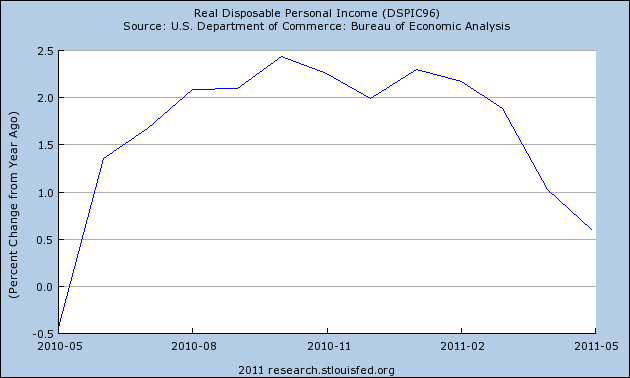With QE2 now in the books it’s pretty obvious that the policy did not generate the kind of growth that most assumed it would. In fact, there is substantial evidence that the policy did little aside from causing a margin squeeze on the entire economy. So while the end of year tax cut appeared like a great benefit to the economy, it was largely offset by the surge in commodity prices and the resulting reallocation of consumer spending.
We didn’t hear much of this bearish scenario last year when the policy was in full force, but now that it’s ending some banks are using the recent decline in commodity prices to make a bullish case. They were wrong to ignore the bump in the road that QE2 caused, but they’re correct in saying that the end of this policy will reduce the speculative premium in many commodity markets which should result in a boost to consumer spending.
In a recent note, UniCredit highlighted how the recent dip in commodity prices should begin to act as a delayed tax cut:
- At the end of last year, the US administration had hoped to kick-start flagging consumption through tax cuts. But the plan failed, as soaring commodity prices have in recent months absorbed not only the tax cuts but the entire increase in disposable incomes.
- Now, however, the tide appears to be turning. Energy prices have fallen strongly in recent weeks and might pull back even further. In addition, food prices have at least stabilized. That means that US households are now enjoying a (delayed) tax cut after all.
- Alongside the boost to purchasing power from falling commodity prices, the US economy will probably also receive support at the beginning of 2H from a rebound in auto sales. As a result, economic numbers in the coming weeks could surprise on the upside – the bounce, however, should only be short-lived.
This effect can best be seen in real disposable income which has sagged in recent months:

UniCredit expands on their tax cut scenario:
“With a lag of half a year, US households are now enjoying a tax cut after all. After rising commodity prices had still absorbed all of the tax relief at the beginning of the year, falling prices are now releasing it again gradually. At the moment, oil prices are close to 40% (annualized) below the 2Q average. When this decline is passed on to consumers, purchasing power will be boosted by just over USD 50bn in 3Q – roughly half of the actual tax cut. Real disposable income is, therefore, likely to increase in 3Q by an annualized 3½%, after merely stagnating in 2Q, and rising by only just ¾% in the past year. A portion of the increase in income (about ¼pp) is likely to be absorbed by a higher personal savings rate, as the servings rate tends to be an automatic stabilizer to rising and falling energy prices (see chart). Nevertheless, the boost to purchasing power will be large enough to allow a tangible acceleration in consumption growth. We expect household spending to increase by 3¼% in 3Q, after rising by less than 2% in the spring.”
I think this is pretty accurate. The US economy should muddle through as the balance sheet recession continues to put pressure on the household sector, but very large government deficits work to offset the de-leveraging. For now, the biggest risks to the US economy are not domestic. They are foreign.
Source: UniCredit
Mr. Roche is the Founder and Chief Investment Officer of Discipline Funds.Discipline Funds is a low fee financial advisory firm with a focus on helping people be more disciplined with their finances.
He is also the author of Pragmatic Capitalism: What Every Investor Needs to Understand About Money and Finance, Understanding the Modern Monetary System and Understanding Modern Portfolio Construction.

Comments are closed.